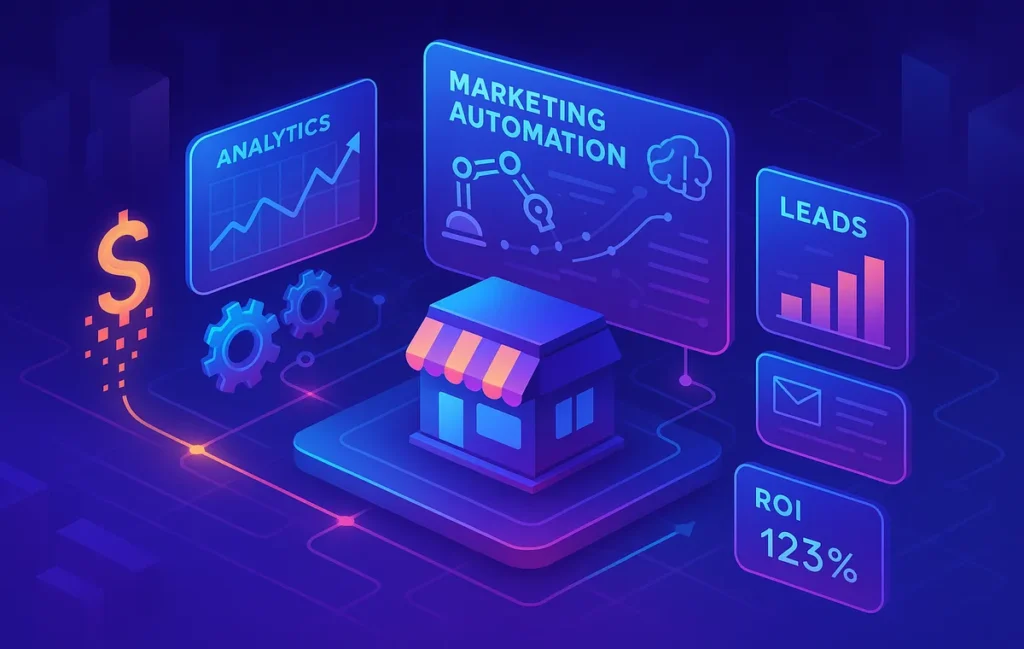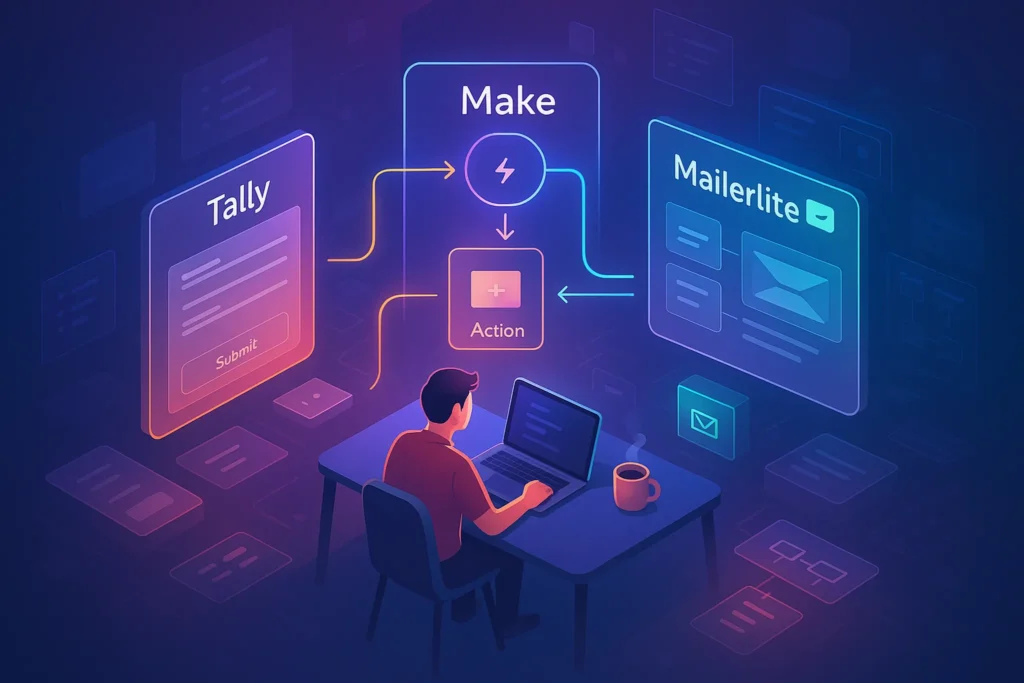🚀 Intro:
For small businesses, every marketing dollar counts. Unlike enterprises with million-dollar budgets, small business owners need tools that pay for themselves quickly. That’s why marketing automation in 2025 is less about flashy features and more about ROI-driven simplicity. Whether it’s nurturing leads, automating follow-ups, or orchestrating campaigns across email, social, and CRM-lite tools, the right platforms save time while directly generating revenue.
This year, AI has accelerated that promise. Many affordable platforms now offer predictive analytics, smart segmentation, and automatic campaign optimization—features once exclusive to enterprise stacks. When a bakery can increase repeat orders by 15% with automated SMS reminders, or a small SaaS boosts conversion by 20% through AI-driven nurture sequences, it’s clear: automation is no longer a luxury. It’s a survival strategy for small businesses.
💡 Nerd Tip: Always measure automation by ROI. If a tool doesn’t earn back at least 3x its subscription cost, it doesn’t belong in your stack.
💼 Why Marketing Automation Matters for Small Businesses
The traditional challenge for SMBs has been bandwidth. Owners juggle sales, service, operations, and marketing, often without a dedicated team. Manual outreach is impossible to scale, and generic tools like spreadsheets collapse once lead volume grows. Marketing automation fills that gap by:
-
Nurturing leads automatically through emails, SMS, or chatbots.
-
Scoring and segmenting prospects so you invest energy where it matters.
-
Orchestrating campaigns across multiple channels without manual scheduling.
-
Integrating light CRM functionality for businesses too small to justify Salesforce.
The difference in 2025 is that these tools are now affordable and ROI-proven. According to industry surveys, 67% of SMBs using marketing automation report recouping costs within the first 90 days.
This is why NerdChips often connects marketing automation discussions with guides like Workflow Automation 101 or 10 Best Email Marketing Tools—because in practice, marketing automation is the front line of ROI for small teams.
🏆 Best Marketing Automation Tools for SMBs in 2025
1. HubSpot Starter Suite
HubSpot remains the leader, but in 2025 its Starter plans have become much friendlier to small businesses. For under $30/month, you get email sequences, landing page builders, and lead scoring—all integrated into a lightweight CRM.
What’s new this year is AI Content Assistant, which auto-drafts campaign emails and landing page copy based on your brand tone. One café owner shared on X:
“HubSpot Starter paid for itself in 3 weeks. Automated reminders brought 20% more customers back.”
💡 Nerd Tip: Start with HubSpot Starter and upgrade only when your pipeline complexity demands it.
2. ActiveCampaign Lite
ActiveCampaign has long been favored for email automation, but its Lite plan is a perfect fit for SMBs in 2025. It combines drip campaigns, lead scoring, and CRM-lite functionality. The real kicker is its AI predictive sending, which chooses the optimal time for each contact.
Benchmarks show SMBs using ActiveCampaign’s predictive features see 14–18% higher open rates. It’s a small optimization that translates into meaningful revenue gains.
💡 Nerd Tip: Pair ActiveCampaign with insights from Email Automation for Non-Techies to set up sequences even if you lack technical skills.
3. MailerLite
MailerLite wins on affordability and design simplicity. In 2025, it expanded into multi-channel automation, adding SMS and pop-up forms alongside email. Its visual editor is especially popular among creative businesses that can’t afford in-house designers.
For a boutique clothing shop, MailerLite’s abandoned cart automations recovered enough sales to cover a year’s subscription in just two months.
💡 Nerd Tip: Use MailerLite if you want a clean balance between design and automation without overspending.
4. Brevo (formerly Sendinblue)
Brevo has rebranded but stayed true to its mission: all-in-one marketing for SMBs. It includes email campaigns, SMS, live chat, and a light CRM. Its standout feature in 2025 is AI-based lead scoring, giving small teams clarity on which prospects to call first.
Brevo is particularly attractive for service-based SMBs—like clinics or consultancies—where every missed lead is lost revenue.
💡 Nerd Tip: Use Brevo’s multi-channel triggers to sync SMS and email for stronger lead nurturing.
5. Keap Grow
Keap focuses on small businesses that want a mix of CRM and marketing automation. In 2025, Keap Grow’s pipeline automation became smarter, automatically moving contacts through deal stages based on email engagement or form submissions.
A small consulting firm reported a 20% improvement in follow-up consistency after adopting Keap Grow. That alone was enough to justify the monthly fee.
💡 Nerd Tip: Keap is ideal for owner-operators who need CRM + automation in one affordable package.
6. Zoho Marketing Plus
Zoho’s strength lies in integration. Its Marketing Plus bundle ties together email, social campaigns, webinars, and analytics under one roof. In 2025, its AI campaign analysis provides instant ROI reports on where to cut or double down.
For small businesses already in the Zoho ecosystem, this is a cost-effective extension. It prevents the “tool overload” problem many SMBs face.
💡 Nerd Tip: If you’re already on Zoho CRM, Marketing Plus is a no-brainer upgrade.
7. BenchmarkONE
Formerly known as Hatchbuck, BenchmarkONE positions itself as “marketing automation for small teams that sell.” Its simplicity is its strength: email automation, lead scoring, and CRM features without bloat.
In 2025, BenchmarkONE added AI subject line testing, giving SMBs a low-cost way to optimize campaigns for higher opens.
💡 Nerd Tip: If your team is just starting, BenchmarkONE reduces the overwhelm of enterprise-level tools.
⚡ Ready to Build Smarter Workflows?
Explore affordable marketing automation tools like HubSpot Starter, ActiveCampaign, and Brevo. Get ROI fast—without enterprise-level complexity.
⚠️ When Marketing Automation Fails for Small Businesses
Not every small business succeeds with automation. The biggest risk is choosing tools without a clear strategy. A bakery owner might buy an enterprise-level platform like Salesforce Marketing Cloud because it “sounds professional,” but after months of paying $1,200/month, they realize they only needed basic email and SMS sequences. The result? Burned cash, frustrated staff, and zero ROI.
Another failure scenario happens when AI automations are left unchecked. A real estate agency in 2024 tried using predictive AI to schedule follow-up emails, but the system started sending repetitive messages that annoyed leads. Their unsubscribe rate doubled within two weeks. Without human oversight, AI can just as easily damage trust as it can build it.
Finally, many small teams underestimate the time cost of setup. Tools like HubSpot or Keap may offer powerful workflows, but if a two-person business doesn’t have time to configure pipelines, the software sits idle.
💡 Nerd Tip: Always start small. Prove ROI with one simple automated campaign—like abandoned cart recovery—before rolling out advanced features.
📐 Quick Comparison Snapshot
| Tool | Price Range (2025) | ROI Payback Time | Best Feature for SMBs |
|---|---|---|---|
| HubSpot Starter | ~$30–$50/month | ~3 weeks | CRM + email sequences |
| ActiveCampaign Lite | ~$20–$40/month | ~1–2 months | Predictive send times |
| Brevo | ~$25–$45/month | ~1 month | SMS + email multi-channel |
| MailerLite | ~$15–$35/month | ~1–2 months | Design-friendly campaigns |
This snapshot shows that the question isn’t “Which is the best?” but “Which pays itself back fastest for your business model.” A restaurant that thrives on SMS reminders may find Brevo unbeatable, while a consultancy needing pipeline clarity might lean toward HubSpot Starter.
💡 Nerd Tip: Match your tool not to your industry, but to the biggest leak in your funnel—that’s where ROI shows up quickest.
📈 Growth & Investor Perspective
Automation isn’t just about saving the owner’s time—it’s also a signal of maturity. Investors, banks, and even local lenders look for businesses that have scalable systems in place. A small e-commerce store that can show data from ActiveCampaign proving a 20% repeat customer rate from nurture campaigns is far more attractive to investors than one relying on manual outreach.
In 2025, investors increasingly ask: “How predictable is your revenue?” Marketing automation helps answer that. When ROI can be demonstrated in reports—like $500 invested in campaigns leading to $2,000 in sales—it makes funding conversations smoother. Even if you’re not looking for venture capital, showing predictable growth makes it easier to secure small business loans or expand with confidence.
💡 Nerd Tip: Keep simple ROI dashboards from your automation tool—investors don’t care about email open rates, they care about revenue lift.
📈 Case Study: How SMBs Get ROI Fast
Take the example of a small café chain in Berlin. They adopted Brevo’s automation in early 2025 to send automated SMS reminders to loyalty members about daily specials. Within two months, they saw a 15% increase in repeat visits, enough to cover a year of subscription fees.
Similarly, an online boutique used MailerLite’s abandoned cart automation. Instead of manually emailing customers who left items in their cart, the system automatically triggered a discount code after 24 hours. The result was a 50% reduction in cart abandonment, translating to $8,000 in extra monthly revenue—over 20x the cost of the tool.
These stories highlight the core truth: marketing automation for SMBs doesn’t just save time—it pays for itself when focused on the right levers.
💡 Nerd Tip: Track one key ROI metric per campaign (repeat purchases, abandoned carts, upsells). Clarity beats complexity.
📊 How Marketing Automation Pays Back Its Cost
For small businesses, the key to adoption is proof that tools don’t just save time—they make money. Here’s how ROI plays out in practice:
-
Lead Nurturing: Automated follow-ups convert leads that would otherwise go cold. One study found SMBs saw a 21% lift in conversion rates after implementing automated nurture sequences.
-
Retention Campaigns: Tools like ActiveCampaign and Keap automate check-ins, reminders, or birthday offers, driving repeat purchases.
-
Time Saved = Revenue Saved: If a small business owner spends five fewer hours a week on manual outreach, that time can be redirected to sales or service delivery.
💡 Nerd Tip: Always track “Revenue Per Campaign” as your north star metric—it reveals automation’s real ROI better than open or click rates.
📬 Want More Smart AI Tips Like This?
Join our free newsletter and get weekly insights on AI tools, no-code apps, and future tech—delivered straight to your inbox. No fluff. Just high-quality content for creators, founders, and future builders.
🔐 100% privacy. No noise. Just value-packed content tips from NerdChips.
🧠 Nerd Verdict
Marketing automation is no longer about enterprise luxury—it’s about survival efficiency for small businesses. In 2025, affordable tools like HubSpot Starter, ActiveCampaign Lite, and Brevo prove that automation can deliver ROI without draining budgets.
At NerdChips, our stance is simple: if your marketing tools don’t earn back their cost within a quarter, you’re using the wrong ones. The best automation platforms for SMBs don’t just promise features—they pay back in measurable growth.
❓ FAQ: Nerds Ask, We Answer
💬 Would You Bite?
If you could automate one part of your marketing today—lead nurturing or customer retention—which would you choose to maximize ROI?
Crafted by NerdChips for creators and teams who want their best ideas to travel the world.



